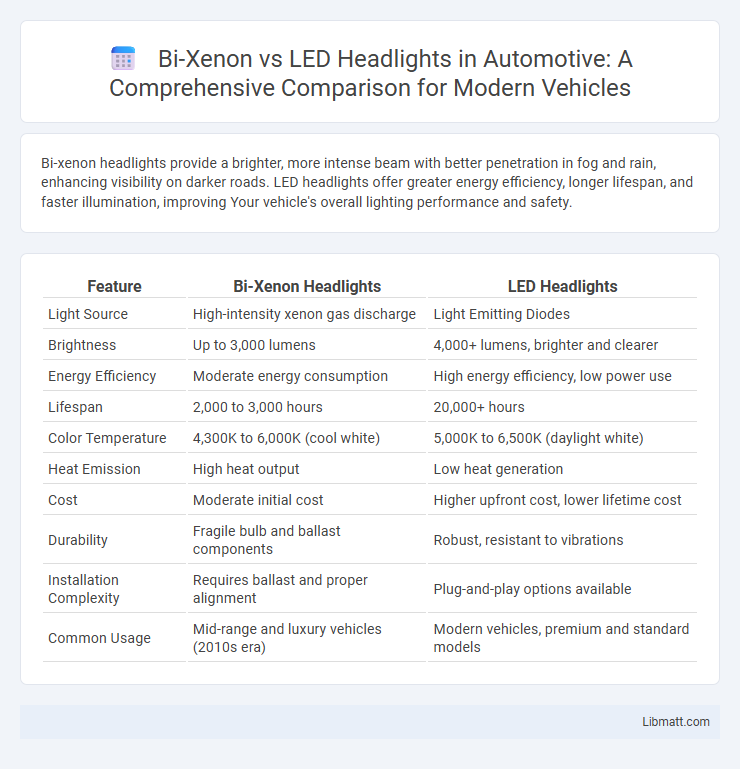Bi-xenon headlights provide a brighter, more intense beam with better penetration in fog and rain, enhancing visibility on darker roads. LED headlights offer greater energy efficiency, longer lifespan, and faster illumination, improving Your vehicle's overall lighting performance and safety.
Table of Comparison
| Feature | Bi-Xenon Headlights | LED Headlights |
|---|---|---|
| Light Source | High-intensity xenon gas discharge | Light Emitting Diodes |
| Brightness | Up to 3,000 lumens | 4,000+ lumens, brighter and clearer |
| Energy Efficiency | Moderate energy consumption | High energy efficiency, low power use |
| Lifespan | 2,000 to 3,000 hours | 20,000+ hours |
| Color Temperature | 4,300K to 6,000K (cool white) | 5,000K to 6,500K (daylight white) |
| Heat Emission | High heat output | Low heat generation |
| Cost | Moderate initial cost | Higher upfront cost, lower lifetime cost |
| Durability | Fragile bulb and ballast components | Robust, resistant to vibrations |
| Installation Complexity | Requires ballast and proper alignment | Plug-and-play options available |
| Common Usage | Mid-range and luxury vehicles (2010s era) | Modern vehicles, premium and standard models |
Introduction to Automotive Lighting Technologies
Bi-xenon headlights utilize xenon gas to produce a bright, white light that offers superior visibility compared to traditional halogen bulbs, featuring a single bulb for both high and low beams. LED headlights, on the other hand, use light-emitting diodes that provide energy-efficient, long-lasting illumination with faster response times and the ability to create adaptive lighting patterns. Your choice between these technologies can affect energy consumption, maintenance costs, and overall driving safety in varied road conditions.
What Are Bi-xenon Headlights?
Bi-xenon headlights use xenon gas to produce both high and low beams from a single light source, offering brighter and more intense illumination compared to traditional halogen bulbs. These headlights provide sharper visibility and longer lifespan, improving safety during nighttime driving. You can expect more efficient energy consumption and a distinct bluish-white light characteristic from bi-xenon systems.
What Are LED Headlights?
LED headlights utilize light-emitting diodes to produce brighter, more energy-efficient illumination compared to traditional Bi-xenon bulbs. These lights offer quicker startup times, longer lifespans, and improved visibility with cooler operating temperatures. Your vehicle benefits from enhanced safety and reduced maintenance costs when equipped with LED headlights.
Brightness and Visibility Comparison
Bi-xenon headlights produce a brighter and more intense light than traditional halogen lamps, offering superior visibility and longer beam reach for safer night driving. LED headlights provide focused, high-intensity illumination with faster response times and lower energy consumption, enhancing contrast and reducing eye strain in various weather conditions. Choosing between bi-xenon and LED depends on your preference for maximum brightness or energy efficiency in visibility performance.
Energy Efficiency: Bi-xenon vs LED
LED headlights consume significantly less energy compared to Bi-xenon headlights, offering enhanced energy efficiency by converting a higher percentage of power into light rather than heat. Bi-xenon lamps require a high voltage discharge to produce light, resulting in greater energy consumption and heat generation. As a result, LED technology not only reduces overall power usage but also contributes to improved vehicle fuel economy and longer battery life.
Lifespan and Durability Differences
Bi-xenon headlights typically have a lifespan of around 2,000 to 3,000 hours, while LED headlights can last up to 30,000 hours or more, making LEDs significantly more durable. The robust construction of LED units offers better resistance to vibrations and shocks compared to bi-xenon bulbs, which have delicate components prone to damage over time. Choosing LED headlights can provide longer-lasting performance and reduce the need for frequent replacements, enhancing your vehicle's reliability.
Cost of Ownership and Maintenance
Bi-xenon headlights typically have higher initial costs and require periodic bulb replacements, leading to increased maintenance expenses over time. LED headlights offer lower energy consumption, longer lifespan, and reduced maintenance needs, making them more cost-effective in the long run. Your total cost of ownership tends to be lower with LED technology due to fewer replacements and improved durability.
Installation and Compatibility Factors
Bi-xenon headlights generally require a more complex installation process involving high-voltage ballasts and specific projector housings, making compatibility with your vehicle's existing wiring and headlight assemblies crucial. LED headlights offer easier plug-and-play installation for many models but may require additional components like CAN bus adapters to prevent error messages. Ensuring your vehicle supports the chosen headlight type and addressing any necessary wiring or housing modifications is essential for optimal performance and safety.
Environmental Impact Assessment
Bi-xenon headlights consume more energy and contain harmful materials like xenon gas, posing environmental risks during manufacturing and disposal. LED headlights offer greater energy efficiency, longer lifespan, and lower toxic waste, significantly reducing environmental impact. Choosing LED technology aligns with sustainable automotive practices and minimizes ecological footprint.
Which Headlight Is Best for You?
Bi-xenon headlights deliver intense, bright light with excellent range, ideal for drivers prioritizing long-distance visibility on highways. LED headlights offer superior energy efficiency, longer lifespan, and faster illumination, making them well-suited for urban driving and frequent stop-and-go traffic. Choosing between bi-xenon and LED depends on your driving environment, with bi-xenon excelling in open-road conditions and LED providing advanced performance and durability for everyday use.
Bi-xenon vs LED headlights Infographic

 libmatt.com
libmatt.com